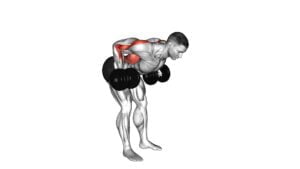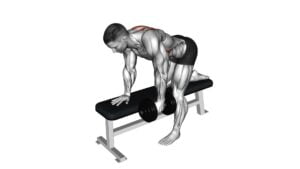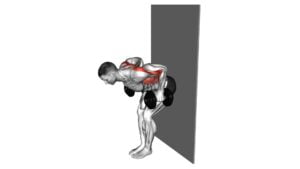Dumbbell Bent-Over Row – Video Exercise Guide & Tips

Get ready to sculpt your back muscles with the Dumbbell Bent-Over Row! This video exercise guide will show you the proper form and technique to target those muscle groups effectively.
Watch This Exercise Video
You'll also discover the awesome benefits of this exercise and learn how to avoid common mistakes. Maximize your results with expert tips and stay safe with important precautions.
It's time to take your fitness to the next level and achieve a stronger, more defined back. Let's get started!
Key Takeaways
- Maintain a strong and stable posture throughout the exercise.
- Engage core muscles to support the spine and keep the back straight.
- Control the weights on the way down to maintain tension and avoid jerking motions.
- Continuously challenge muscles to stimulate growth and progress.
Proper Form and Technique
To perform the dumbbell bent-over row with proper form and technique, focus on maintaining a strong and stable posture throughout the exercise.
Many people make the mistake of rounding their back or hunching their shoulders, which can lead to injury and ineffective results.
Instead, start by standing with your feet shoulder-width apart and a slight bend in your knees. Engage your core muscles to support your spine and keep your back straight, avoiding any excessive arching or rounding.
As you bend forward at the hips, maintain this strong posture and keep your head in line with your spine. Grip the dumbbells with your palms facing your body and your arms fully extended.
Throughout the movement, keep your elbows pointed out to the sides and close to your body. As you lift the dumbbells towards your chest, focus on squeezing your shoulder blades together and keeping your back muscles engaged.
Avoid using momentum or swinging your body to lift the weights. Lower the dumbbells back down in a controlled manner, maintaining the same stable posture.
Muscle Groups Targeted
The dumbbell bent-over row primarily targets the muscles of the upper back, including the rhomboids, trapezius, and latissimus dorsi. These muscles play a crucial role in maintaining good posture, shoulder stability, and overall upper body strength.
The latissimus dorsi, also known as the lats, are the largest muscles in the upper back. They're responsible for the adduction, extension, and internal rotation of the shoulder joint. By performing the dumbbell bent-over row, you engage your latissimus dorsi, helping to build strength and size in this muscle group.
The rhomboids, located between the shoulder blades, are responsible for retracting the scapulae, or pulling them towards the midline of the body. This action helps to improve posture and strengthen the upper back. During the dumbbell bent-over row, the rhomboids are activated as you squeeze your shoulder blades together at the top of the movement.
Incorporating the dumbbell bent-over row into your workout routine can help you develop a strong and well-rounded upper back. It's important to maintain proper form and technique to effectively target these muscle groups. Remember to keep your back straight, engage your core, and pull the dumbbells towards your lower chest while maintaining a controlled movement.
Benefits of the Dumbbell Bent-Over Row
To maximize your upper back strength and improve your posture, incorporate the dumbbell bent-over row into your workout routine. This exercise offers a range of health benefits, making it a valuable addition to any fitness program.
One of the main advantages of the dumbbell bent-over row is that it targets multiple muscle groups simultaneously. By engaging your upper back, shoulders, and arms, it helps to strengthen and tone these areas. Additionally, the rowing motion helps to improve your overall posture by counteracting the effects of hunching over a desk or computer for long periods.
Furthermore, the dumbbell bent-over row offers various variations and progressions that can be tailored to your fitness level and goals. You can increase the difficulty by using heavier dumbbells or performing the exercise on an unstable surface, such as a BOSU ball. Alternatively, you can focus on specific muscle groups by adjusting your grip or hand position.
By incorporating the dumbbell bent-over row into your routine and experimenting with different variations, you can continue to challenge your muscles and make progress towards your fitness goals.
Now, let's move on to the next section and discuss common mistakes to avoid when performing this exercise.
Common Mistakes to Avoid
To avoid common mistakes and ensure proper form, follow these tips when performing the dumbbell bent-over row:
- Maintain a neutral spine: Avoid rounding or arching your back during the exercise. Keep your spine in a straight line from your head to your tailbone.
- Engage your core: Activate your abdominal muscles throughout the movement to provide stability and protect your lower back.
- Avoid using momentum: Focus on using your back muscles to initiate the movement rather than relying on your arms or swinging the weights. This will ensure that you're targeting the correct muscles and avoiding injury.
- Technique Tips:
- Keep your elbows close to your body: As you pull the dumbbells towards your chest, make sure your elbows stay tucked in. This will engage your back muscles more effectively.
- Squeeze your shoulder blades: At the top of the movement, squeeze your shoulder blades together to fully engage your upper back muscles.
- Control the weights on the way down: Lower the dumbbells in a controlled manner to maintain tension in your muscles and avoid any jerking or bouncing motions.
Tips for Maximizing Results
To maximize your results, focus on incorporating these strategies into your dumbbell bent-over row routine.
- First and foremost, pay attention to your intensity levels for optimal results. This exercise is all about engaging your back muscles, so make sure you choose a weight that challenges you without sacrificing proper form. Push yourself to the point of muscle fatigue, but always prioritize maintaining good posture and control throughout the movement.
- Another tip for maximizing results is to incorporate variations into your routine to stimulate different muscles. By changing the grip or angle of your rows, you can target different areas of your back and shoulders. Try using an overhand grip or an underhand grip, or even a neutral grip with your palms facing each other. Additionally, you can vary the angle at which you perform the exercise by using an incline bench or adjusting the height of your torso.
- Remember, the key to maximizing results is to continuously challenge your muscles. Gradually increase the weight you use or the number of repetitions you perform as your strength improves. By consistently pushing yourself and incorporating variations, you'll stimulate your muscles in new ways and continue to make progress.
Stay focused, stay consistent, and watch as your back muscles become stronger and more defined.
Safety Precautions and Modifications
Before beginning the dumbbell bent-over row, ensure that you have a sturdy grip on the weights and maintain a stable stance throughout the exercise. Safety precautions are important to prevent injuries and get the most out of your workout.
Here are some tips to keep in mind:
- Start with lighter weights: If you're new to the exercise or have any concerns about your strength or form, it's advisable to start with lighter dumbbells. This will allow you to focus on your technique and gradually increase the weight as you become more comfortable.
- Use proper form: Maintaining a neutral spine and a slight bend in your knees is crucial to protect your lower back. Avoid rounding your shoulders and instead, keep them pulled back and down. Engage your core muscles throughout the movement to provide stability.
- Modify the exercise: If you have any existing shoulder or back injuries, you may need to modify the dumbbell bent-over row. Instead of performing the exercise with both arms simultaneously, try doing a single-arm row or using resistance bands to reduce strain on the affected area.
- Explore alternative exercises: If the dumbbell bent-over row doesn't suit your fitness level or goals, there are alternative exercises you can try. Cable rows, inverted rows, or seated rows are all effective variations that target the same muscle groups.
Frequently Asked Questions
How Heavy Should the Dumbbells Be for the Bent-Over Row Exercise?
When it comes to the bent-over row exercise, it's important to choose the right weight for your dumbbells. The recommended weight will depend on your fitness level and strength.
To maintain proper form and reduce the risk of injury, start with lighter dumbbells and gradually increase the weight as you get stronger.
Remember to keep your back straight, engage your core, and pull the dumbbells towards your chest, squeezing your shoulder blades together.
Can I Perform the Dumbbell Bent-Over Row With a Barbell Instead?
Yes, you can perform the dumbbell bent-over row with a barbell instead. The barbell row is a great alternative to the dumbbell row as it allows you to lift heavier weights and engage more muscles in your back, shoulders, and arms.
It also helps improve your grip strength and overall upper body strength. However, it's important to maintain proper form and technique to prevent injuries, so make sure you have a strong core and stable lower back when performing the exercise.
How Often Should I Include the Dumbbell Bent-Over Row in My Workout Routine?
To optimize your workout routine, it's important to include the dumbbell bent-over row regularly. This exercise targets multiple muscles in your back and arms, helping to improve strength and posture.
As for how often to include it, aim for 2-3 times a week, allowing for proper rest and recovery between sessions.
As for dumbbell weight, start with a weight that challenges you but still allows for proper form. Gradually increase the weight as you get stronger.
Can I Substitute the Dumbbell Bent-Over Row With Another Exercise That Targets Similar Muscle Groups?
Yes, you can substitute the dumbbell bent-over row with other exercises that target similar muscle groups. There are alternative exercises like the barbell row, cable row, and machine row that can provide similar benefits.
The dumbbell bent-over row is great for developing back muscles and improving posture. However, it's important to vary your workouts and incorporate different exercises to prevent muscle imbalances and keep your workouts challenging and effective.
Are There Any Variations of the Dumbbell Bent-Over Row That I Can Try for Added Challenge or Variety?
Looking to add variety and challenge to your workout? There are several variations of the dumbbell bent-over row that you can try.
These variations include single-arm dumbbell bent-over row, renegade row, and wide-grip bent-over row.
These exercises target similar muscle groups and provide additional benefits such as improved strength and muscular endurance.
Incorporating these variations into your routine can help keep your workouts interesting and maximize your results.
Conclusion
In conclusion, the dumbbell bent-over row is a highly effective exercise for targeting multiple muscle groups in the upper body.
By maintaining proper form and technique, you can maximize the benefits and avoid common mistakes.
Remember to start with a weight that's challenging but manageable, and gradually increase as you gain strength.
By following these tips and taking necessary safety precautions, you can achieve great results and improve your overall fitness.

Author
Years ago, the spark of my life’s passion ignited in my mind the moment I stepped into the local gym for the first time. The inaugural bead of perspiration, the initial endeavor, the very first surge of endorphins, and a sense of pride that washed over me post-workout marked the beginning of my deep-seated interest in strength sports, fitness, and sports nutrition. This very curiosity blossomed rapidly into a profound fascination, propelling me to earn a Master’s degree in Physical Education from the Academy of Physical Education in Krakow, followed by a Sports Manager diploma from the Jagiellonian University. My journey of growth led me to gain more specialized qualifications, such as being a certified personal trainer with a focus on sports dietetics, a lifeguard, and an instructor for wellness and corrective gymnastics. Theoretical knowledge paired seamlessly with practical experience, reinforcing my belief that the transformation of individuals under my guidance was also a reflection of my personal growth. This belief holds true even today. Each day, I strive to push the boundaries and explore new realms. These realms gently elevate me to greater heights. The unique combination of passion for my field and the continuous quest for growth fuels my drive to break new ground.







